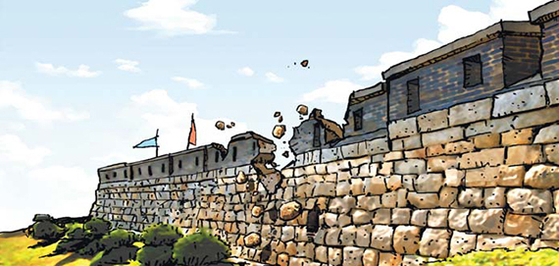The problem is internal division

The author is the international news editor of the JoongAng Ilbo.
One of the experiences I can still recall from my days as a correspondent in Washington is meeting a white man holding a sign at a conservative rally in September 2015. Donald Trump, who was taking the country by storm at the time, showed up at the rally. But what was unexpected was how the man used Korea as an example to argue for a wall to stop illegal immigration. Holding a sign that read “Trump” along with his colleagues, the man said Korea too had a wall, so America needed one too. Then he brought up the example of a high school in Alexandria, Virginia, which he said taught students in Spanish rather than in English. “How in the world does this make sense?” he asked. “My taxes are going to a school that uses Spanish. My money is being used to teach the children of immigrants.”
The crowd at the rally raved about Trump’s scriptless, ad-hoc speech. For those whose thoughts have been repressed under the idea of political correctness, Trump’s unfettered words were like an oasis.
Now, the front lawn of the U.S. Congress, where Trump made his stump six years ago, testifies to the results of his four-year term. The vicinity of the Congress was off limits due to the storming of the building by far-right groups ahead of President-elect Joe Biden’s inauguration on Wednesday.
Trump, who was elected on the fears and anxiety of white society fearing their lives being encroached upon by illegal immigrants and others, has left office without relieving such worries and much less having reduced conflict between white Americans and others. The United States now battles a serious internal crisis in the aftermath of four years of Trump. For an empire that rules over a vast territory and multiple peoples under one roof, challenges lie in both external and internal rule. Empires must struggle with maintaining unity while harnessing the benefits of diversity. They must fight off enemies outside their borders, while staying united behind its walls. Ancient Goguryeo (37 B.C.-A.D. 668) fought off repeated invasions by the Sui and Tang Dynasties of China, but its mountain fortresses crumbled when its strongman died and his three sons fought amongst each other.

But Trump’s four years remind the United States that its greatest threat lay from within. Trump built a border fence on its southern frontier. But the empire’s walls were already crumbling from inside. Illegal immigration may have been curbed with the wall, but the walls of racial and ideological separation inside were stacked even higher.
Polls conducted on the shocking storming of the U.S. Congress show just how divided America currently is. A survey done on the day of the storming, Jan. 6, by YouGov, showed that 62 percent of respondents felt the incident was a threat on democracy. But looking more deeply exposes the fault lines, with 68 percent of Republicans said the storming was not a threat, while 93 percent of Democrats saw it as a threat. Subsequent polls reflected similar divisions based on party lines.
Trump’s failure signifies the failure of U.S. parliamentary politics. Being an outsider to Washington without a clear support base among the establishment, Trump rallied his supporters through direct appeals, which in turn diminished the capacity of the legislature to mediate conflicts and reach compromises. Trump’s rise showed how Congress was devolving into a league of own instead of being a representative body of public will capable of arbitrating through different interests.
How will historians write about today’s America hundreds of years from now? They may see the present as the beginning of the decline of the American Empire, or a second Civil War of sorts where a new form of unity could emerge from the ashes of conflict. Which direction America takes depends on the leadership of President Joe Biden and future post-Trump presidents.










with the Korea JoongAng Daily
To write comments, please log in to one of the accounts.
Standards Board Policy (0/250자)